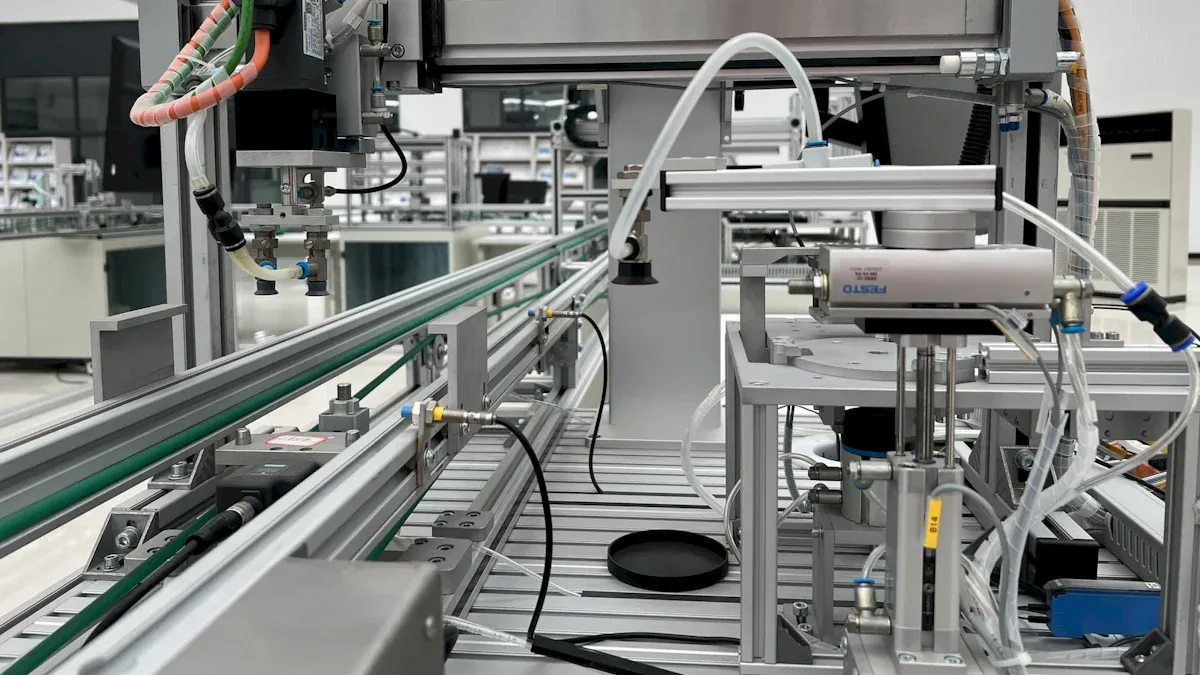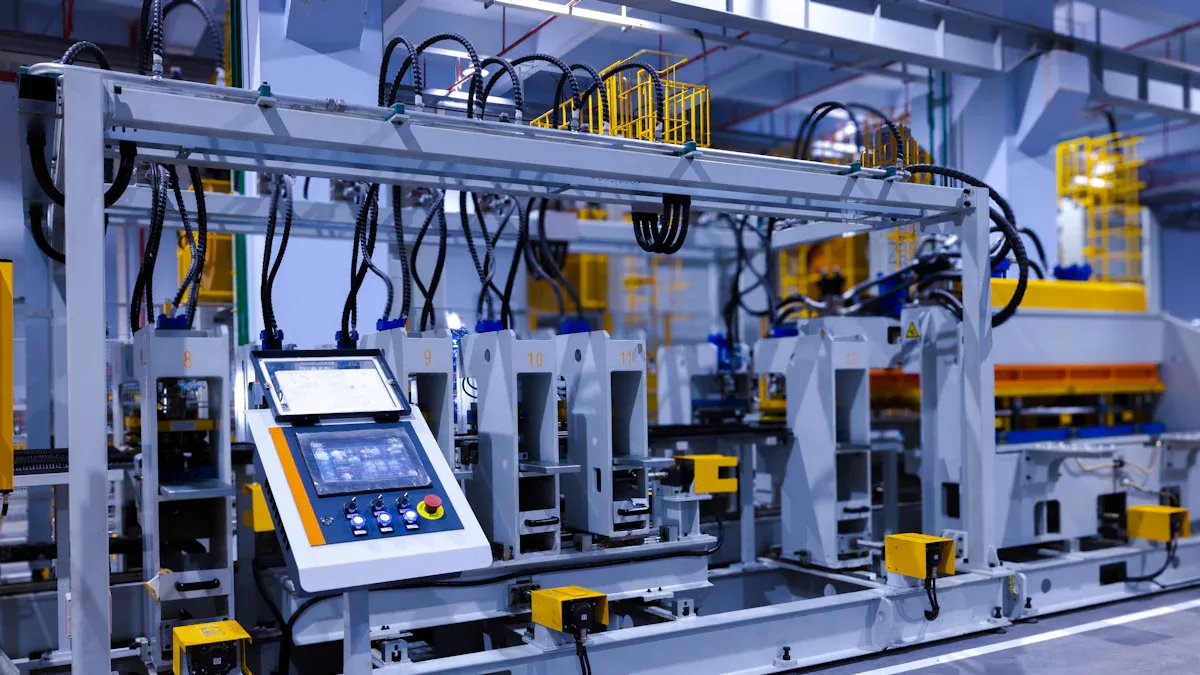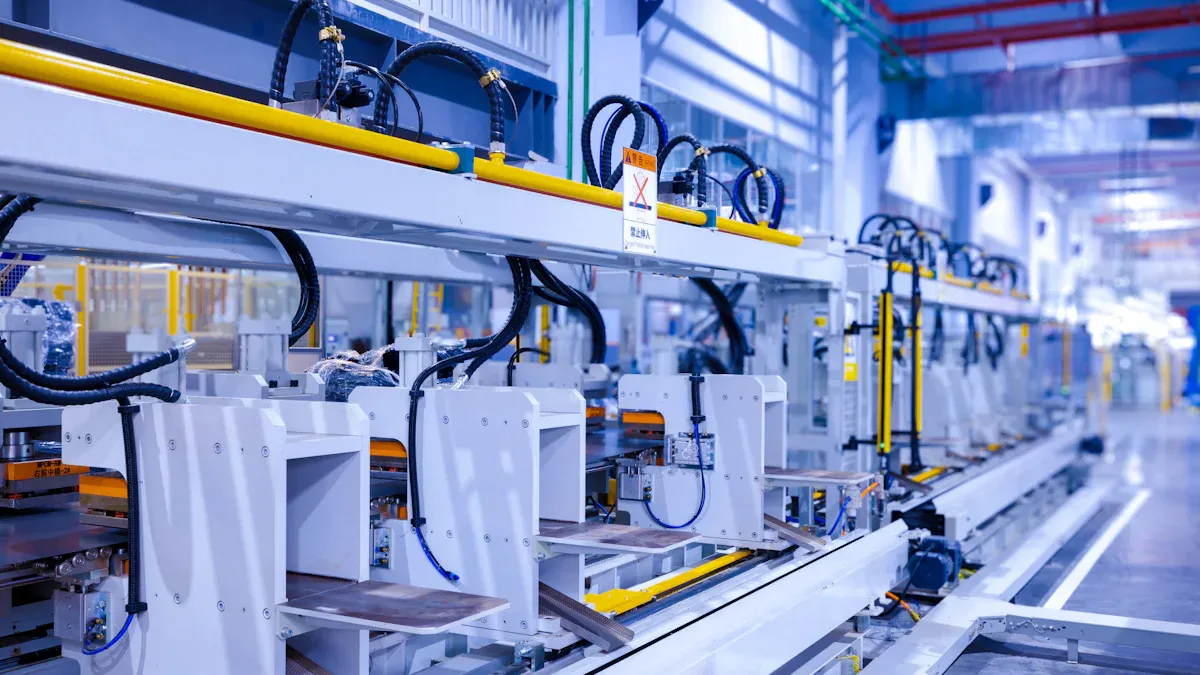
A PCB Conveyor moves printed circuit boards automatically between different stages of the SMT production line. This equipment helps transfer boards smoothly through assembly, inspection, and testing. By keeping conveyor speeds steady—usually between 0.8 and 1.2 meters per minute—manufacturers can prevent common defects like solder balling and component shifting. The use of statistical process control also supports better performance and higher product quality.
Key Takeaways
-
PCB conveyors automate the movement of circuit boards, speeding up production and reducing errors.
-
Adjustable settings on conveyors allow handling of different board sizes while keeping boards steady and aligned.
-
Different conveyor types serve specific roles, such as smooth transport, precise rotation, and defect removal.
-
Automated conveyors improve product quality by reducing damage and supporting accurate component placement.
-
Regular maintenance and real-time monitoring keep conveyors reliable and minimize production downtime.
PCB Conveyor Overview

Definition
A PCB Conveyor in SMT production lines refers to a device designed to move printed circuit boards between workstations. This equipment uses a conveyor belt, a driving device, and a control system to transport boards efficiently. The conveyor adjusts speed and direction to protect PCBs from damage caused by speed mismatches. Manufacturers build these conveyors from strong materials such as aluminum or stainless steel, which ensures durability for industrial use. Programmable controls and modular designs allow customization for different production needs. Energy-saving technologies help reduce power consumption. The main goal is to provide stable, reliable, and flexible movement for various PCB types and sizes.
Note: PCB Conveyors play a vital role in maintaining safe and accurate PCB transmission throughout the SMT process.
Core Purpose
The core purpose of a PCB Conveyor centers on automating and streamlining the movement of PCBs through each stage of SMT production. These conveyors transport boards between assembly, inspection, and testing stations. They support different PCB sizes and configurations, showing adaptability in fast-paced environments. Sensors and control systems monitor and guide each board, ensuring smooth and efficient movement. Adjustable speed and automatic width settings help match the requirements of each production run. Integrated inspection systems maintain high production quality.
-
They shorten cycle times and boost overall productivity.
-
Automated conveyors increase production speed and efficiency by reducing manual handling.
-
Reliable transfer reduces the risk of damage and handling errors.
-
Automated inspection systems lower defect and scrap rates.
-
Consistent quality and reduced rework result from automation.
Compared to manual handling, PCB conveyors improve throughput and lower error rates. Automation enhances precision and consistency, which leads to better results in SMT lines.
Operation in SMT Lines

Transport Process
A PCB Conveyor moves boards between each stage of the SMT line. The conveyor uses belts or chains to carry PCBs from one machine to the next. Sensors detect the position of each board and help prevent jams or misalignment. Operators can adjust the conveyor’s speed to match the pace of the production line. This flexibility allows the system to handle different board sizes and thicknesses. Adjustable rails and automatic width settings help the conveyor fit a wide range of PCB designs. The conveyor’s smooth movement protects delicate components and reduces the risk of damage.
Integration with Equipment
Manufacturers design PCB conveyors to work with various SMT machines, such as pick-and-place systems, solder paste printers, and reflow ovens. The conveyor links these machines together, creating a continuous flow. Each conveyor section can communicate with the equipment it serves. For example, when a pick-and-place machine finishes loading components, the conveyor automatically moves the board to the next station. This integration reduces manual handling and keeps the process efficient. The conveyor’s control system can pause or resume movement based on signals from connected machines, which helps maintain proper timing.
Workflow Coordination
PCB conveyors play a key role in coordinating the workflow across the SMT line. They transport boards through assembly, inspection, and testing stages, ensuring a steady and organized flow. This optimized movement increases production efficiency and supports smooth coordination between different machines. By reducing manual board handling, conveyors minimize human intervention and lower the risk of errors. They also help increase manufacturing throughput by streamlining the movement of PCBs. The use of conveyors mitigates bottlenecks and delays, which improves the overall production flow.
Tip: Automated conveyors not only speed up production but also help maintain consistent quality by reducing the chance of mistakes during board transfer.
PCB Conveyor Types
A variety of PCB Conveyor types support different tasks in SMT production lines. Each type offers unique features that help maintain smooth, efficient, and high-quality assembly. The table below summarizes the most common conveyor types, their working principles, and typical applications:
|
Conveyor Type |
Working Principle |
Main Features |
Typical Applications |
|---|---|---|---|
|
Chain Conveyor |
Uses metal or anti-static plastic chains driven by motors to transport PCBs. |
High temperature resistance, strong bearing capacity, and optional anti-static design. |
High-speed, large-volume lines; after high-temp processes; heavy or large PCBs like server boards. |
|
Belt Conveyor |
Uses rubber or anti-static PU belts driven by rollers or wheels. |
Smooth transmission reducing vibration; lightweight and flexible; suitable for various PCB sizes. |
Before/after SMT patching; standard or small PCBs; low noise and vibration environments. |
|
Roller Conveyor |
Multiple parallel rollers are driven manually or mechanically to roll PCBs. |
Cost-effective; supports heavier loads; adjustable for different PCB sizes; simple maintenance. |
Short-distance transport; SMT buffer conveyors; manual inspection; small/medium production lines. |
|
Bull’s Eye Conveyor |
Rotating platform to adjust PCB orientation precisely for docking. |
Precise rotation control; high adaptability; strong stability with a high-precision mechanism. |
Aligning PCBs for plug-in processes; optimizing production line layout. |
|
Multifunctional Conveyors |
Integrate functions like inspection, cooling, reject, telescopic, flipper, turn, shuttle, and rotating conveyors. |
Enhance flexibility and efficiency; features vary by function (e.g., cooling airflow, flipping mechanism). |
Inspection stations; cooling after soldering; defect rejection; flexible path adjustment; double-sided mounting. |
Belt Conveyors
Belt conveyors use rubber or anti-static polyurethane belts to move PCBs smoothly between SMT machines. These conveyors reduce vibration and noise, which protects delicate components. Operators can adjust the belt speed and width to fit different board sizes. Belt conveyors work well for standard or small PCBs, especially before or after SMT patching. Their lightweight and flexible design makes them a popular choice for many production lines.
Rotating Conveyors
Rotating conveyors help change the direction and orientation of PCBs during assembly. They rotate boards by 90, 180, or 270 degrees, allowing precise alignment for the next process. This rotation supports efficient SMT assembly and helps optimize the layout of the production line. The modular design and built-in safety features, such as torque limiters, ensure safe operation. Rotating conveyors also allow manufacturers to customize the traffic flow of PCBs, which increases flexibility.
Link Conveyors
Link conveyors connect different SMT equipment, such as screen printers, chip mounters, and reflow ovens. They provide buffering and maintain proper spacing between machines. This buffering prevents bottlenecks and keeps the production line running smoothly. Link conveyors support modular expansion and reduce manual handling. They also use anti-static materials and adjustable settings to ensure safe and stable PCB movement.
Note: Link conveyors play a key role in improving production flow and reducing handling risks.
Reject Conveyors
Reject conveyors handle PCBs that do not meet quality standards, often called NG (No Good) boards. These conveyors transfer and cool boards after reflow soldering. Their sturdy steel construction and stable design prevent shifting during operation. Adjustable rails and variable speed controls allow precise handling of different PCB sizes. Reject conveyors also support testing during transfer and use dedicated slots to prevent boards from sticking. By separating defective boards, reject conveyors help maintain quality control and reduce damage risk.
Specialized conveyors, such as those for inspection or buffering, support continuous flow and high-quality assembly. They help manufacturers maintain efficiency and accuracy throughout the SMT process.
Functions and Benefits
Efficiency
A PCB Conveyor increases efficiency in SMT production lines by automating the movement of boards between machines. This automation reduces manual handling and speeds up the entire process. Modular conveyor designs allow manufacturers to reconfigure lines quickly for new products or changes in demand. Production teams can add parallel lines or expand capacity as needed. The conveyor system supports lean manufacturing by enabling efficient cell-based layouts and quick changeovers. Flexible material handling and seamless integration with robotic systems help maintain a steady workflow. These features make it easier to scale up for mass production while keeping operations smooth.
Tip: Efficient PCB transport helps manufacturers meet tight deadlines and adapt to changing production needs.
Accuracy
Accurate component placement is critical in SMT assembly. PCB conveyors play a major role in achieving this goal. They provide precise, smooth, and consistent transport of boards, which helps keep each PCB aligned for pick-and-place machines. Adjustable speeds and width settings allow the conveyor to handle different board sizes without losing alignment. Seamless integration with inspection equipment and automated systems reduces errors and rework. The conveyor minimizes board damage and maintains uniform placement, which directly improves accuracy. Modular and customizable designs with user-friendly controls support consistent quality throughout the assembly line.
-
Precise and stable PCB movement supports accurate component placement.
-
Adjustable settings accommodate various board sizes and maintain alignment.
-
Integration with automation reduces manual errors and rework.
-
Consistent transport minimizes PCB damage and supports uniform results.
Quality Control
Quality control remains a top priority in electronics manufacturing. PCB conveyors help maintain high standards by supporting automated inspection and defect handling. They separate defective boards using reject conveyors, which prevent faulty products from moving further down the line. The conveyor system also reduces the risk of PCB warpage and misalignment. By optimizing conveyor speed and temperature profiles in reflow ovens, manufacturers ensure uniform heating. This uniformity lowers the chance of warping during soldering. Mechanical support and clamping during reflow, provided by the conveyor, help keep boards stable and aligned.
-
Mechanical support and clamping prevent misalignment.
-
Automated inspection and defect handling improve overall product quality.
Downtime Reduction
Minimizing downtime is essential for high-volume SMT production. PCB conveyors support seamless integration with various machines, ensuring smooth transitions between each stage. Advanced features like automated splicing and high-speed handling reduce production stoppages. Precision-guided systems and high-speed motors transport boards quickly and accurately. Safety features, such as emergency stop buttons and automatic shutdowns, prevent malfunctions from causing long delays. Easy maintenance and durable construction allow for quick recovery and continuous operation.
Routine maintenance practices help keep the conveyor system reliable:
-
Implement a preventive maintenance program with regular inspections, cleaning, and part replacements.
-
Inspect plumbing, seals, and ventilation to prevent leaks and spills.
-
Use compatible materials for parts and replacements to avoid deterioration.
-
Clean filters and spray nozzles regularly to maintain efficiency.
-
Keep dry process equipment clean, especially in cleanroom environments.
-
Use preventive maintenance to diagnose issues early and avoid emergency repairs.
-
Work with equipment manufacturers to develop and support maintenance schedules.
Continuous condition monitoring also helps reduce unplanned downtime:
-
Sensors track the health of motors, belts, and bearings in real time.
-
Early fault detection algorithms identify signs of wear or failure.
-
Automated alerts notify maintenance teams about urgent inspections.
-
Targeted maintenance reduces costs and extends equipment life.
Note: Regular maintenance and real-time monitoring keep the SMT line running smoothly and prevent unexpected stoppages.
PCB conveyors ensure smooth, continuous, and damage-free handling of circuit boards in SMT production lines. They support high precision and reliability, using advanced materials and intuitive interfaces to minimize errors. Manufacturers benefit from customizable designs and integration with automated systems, which streamline operations and maintain production pace. Industry trends, such as miniaturization and smart manufacturing, highlight the growing need for efficient conveyor solutions. These systems play a vital role in meeting the demands of electronics, healthcare, and automotive sectors.
FAQ
What is the main function of a conveyor in SMT production?
A conveyor moves circuit boards between machines in the assembly line. It helps keep the process fast and organized. This system reduces mistakes and protects the boards from damage.
How do conveyors help improve product quality?
Conveyors keep boards steady and aligned during transport. This stability helps machines place parts accurately. Fewer mistakes mean higher quality and less waste.
Can conveyors handle different board sizes?
Yes. Many conveyors have adjustable rails and settings. These features allow them to move small or large boards without problems.
Why do manufacturers use automated conveyors?
Automated conveyors speed up production and lower labor costs. They also reduce the risk of human error. This leads to more reliable and efficient assembly lines.
How often should conveyor systems receive maintenance?
Regular maintenance is important. Most manufacturers check and clean conveyors weekly or monthly. This routine care helps prevent breakdowns and keeps the line running smoothly.
